Cloning, functional analysis and post-transcriptional regulation of a type II DNA topoisomerase from Leishmania infantum. A new potential target for anti-parasite drugs
- PMID: 12907735
- PMCID: PMC169929
- DOI: 10.1093/nar/gkg671
Cloning, functional analysis and post-transcriptional regulation of a type II DNA topoisomerase from Leishmania infantum. A new potential target for anti-parasite drugs
Abstract
We identified a type II topoisomerase enzyme from Leishmania infantum, a parasite protozoon causing disease in humans. This protein, named Li topo II, which displays a variable C-terminal end, is located in the kinetoplast. The cloned gene encoding Li-TOP2 compensates for the slow growth of topo II-deficient mutants of Saccharomyces cerevisiae, resulting in a catalytically active DNA topoisomerase in yeast. Analysis of the specific mRNA levels of the Li-TOP2 gene showed variations throughout the parasite cell cycle in synchronized cells as well as between the distinct forms of the parasite. Thus, the enzyme had higher levels of mRNA expression in the highly infective intracellular form of the parasite, the amastigote, than in the extracellular promastigote form, suggesting a relation with the distinct developmental and infectious phases of the protozoon. In addition, western blot analysis showed differences in protein expression between the proliferative and non-proliferative forms of L.infantum promastigotes, which displayed similar levels of mRNA. This indicated possible post-transcriptional regulation mechanisms. The data suggest that Li topo II has a part in DNA decatenation and probably at the initial stages of proliferation in the intracellular form of L.infantum, a parasite that has to proliferate into the host macrophage to survive its hostile environment in its first moments of intracellular infection.
Figures
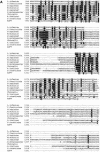


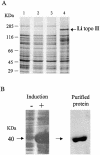
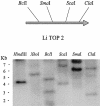
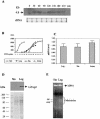

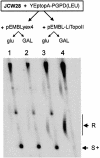

Similar articles
-
Nuclear DNA polymerase beta from Leishmania infantum. Cloning, molecular analysis and developmental regulation.Nucleic Acids Res. 2001 Sep 15;29(18):3822-34. doi: 10.1093/nar/29.18.3822. Nucleic Acids Res. 2001. PMID: 11557814 Free PMC article.
-
S-adenosylmethionine decarboxylase from Leishmania infantum promastigotes: molecular cloning and differential expression.Parasitol Res. 2002 May;88(5):421-6. doi: 10.1007/s00436-001-0581-4. Parasitol Res. 2002. PMID: 12049458
-
Molecular characterization of a nuclear topoisomerase II from Nicotiana tabacum that functionally complements a temperature-sensitive topoisomerase II yeast mutant.Plant Mol Biol. 2003 Jul;52(5):1063-76. doi: 10.1023/a:1025427700337. Plant Mol Biol. 2003. PMID: 14558665
-
Cytoplasmic SIR2 homologue overexpression promotes survival of Leishmania parasites by preventing programmed cell death.Gene. 2002 Aug 21;296(1-2):139-50. doi: 10.1016/s0378-1119(02)00842-9. Gene. 2002. PMID: 12383511
-
DNA supercoiling in vivo.Biophys Chem. 1988 Feb;29(1-2):7-15. doi: 10.1016/0301-4622(88)87020-0. Biophys Chem. 1988. PMID: 2833949 Review.
Cited by
-
The effect of topoisomerase II inhibitors on the kinetoplast ultrastructure.Parasitol Res. 2004 Dec;94(6):439-48. doi: 10.1007/s00436-004-1223-4. Epub 2004 Oct 28. Parasitol Res. 2004. PMID: 15517387
-
Trypanosomatids topoisomerase re-visited. New structural findings and role in drug discovery.Int J Parasitol Drugs Drug Resist. 2014 Aug 24;4(3):326-37. doi: 10.1016/j.ijpddr.2014.07.006. eCollection 2014 Dec. Int J Parasitol Drugs Drug Resist. 2014. PMID: 25516844 Free PMC article. Review.
-
The double-edged sword in pathogenic trypanosomatids: the pivotal role of mitochondria in oxidative stress and bioenergetics.Biomed Res Int. 2014;2014:614014. doi: 10.1155/2014/614014. Epub 2014 Mar 31. Biomed Res Int. 2014. PMID: 24800243 Free PMC article. Review.
-
Leishmania actin binds and nicks kDNA as well as inhibits decatenation activity of type II topoisomerase.Nucleic Acids Res. 2010 Jun;38(10):3308-17. doi: 10.1093/nar/gkq051. Epub 2010 Feb 10. Nucleic Acids Res. 2010. PMID: 20147461 Free PMC article.
-
Theoretical models of DNA topology simplification by type IIA DNA topoisomerases.Nucleic Acids Res. 2009 Jun;37(10):3125-33. doi: 10.1093/nar/gkp250. Epub 2009 Apr 21. Nucleic Acids Res. 2009. PMID: 19383879 Free PMC article. Review.
References
-
- Neva F. and Sacks,S. (1995) Leishmaniasis. In Warren,K.S. and Mahmoud,A.A.S. (eds), Leishmaniasis in Tropical and Geographical Medicine. McGraw-Hill, New York, pp. 296–308.
-
- Jimenez M.I., Gutierrez-Solar,B., Benito,A., Aguiar,A., García,E., Carcenado,E. and Alvar,J. (1991) Cutaneous Leishmania infantum zymodems isolated from bone marrow in AIDS patients. Res. Rev. Parasitol., 51, 91–95.
-
- Sacks D.L. and Perkins,P.V. (1984) Identification of an infective stage of Leishmania promastigotes. Science, 223, 1417–1419. - PubMed
Publication types
MeSH terms
Substances
LinkOut - more resources
Full Text Sources
Molecular Biology Databases
Miscellaneous

